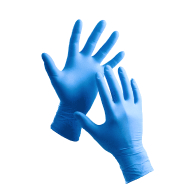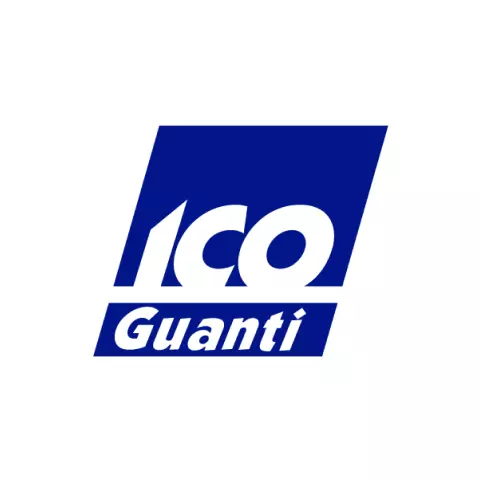Icoguanti PALMPRO 662 Nitrile Synthetic Glove
Icoguanti
visit storeProduct description
Nitrile blue, powder-free, micro-rough, weight gr. 3.0, thickness 0.07 mm - M.D. Class I and PPE Cat. III Risk - Food contact
Refers to whether gloves have a smooth or textured finish, affecting grip strength, dexterity, and handling ability in wet or dry conditions.
Indicates the glove's pigmentation, which can aid in color-coding tasks, enhancing visibility, or meeting specific industry requirements for contamination control.
Indicates whether gloves contain donning powder. Powder-free options reduce allergen risks and contamination, while powdered versions offer easier application.
Describes whether fingertips have a smooth or textured surface, affecting grip strength, tactile sensitivity, and handling precision for various applications.
Offers complete hand coverage, ensuring hygiene and protection. Ideal for various tasks requiring a barrier against contamination and maintaining cleanliness.
Offers versatile hand protection for various tasks. Balances durability and flexibility, suitable for diverse applications requiring barrier protection.
Designed for use on either hand, these gloves offer convenience and efficiency. Their symmetrical design simplifies donning and reduces waste.
Indicates the total mass of the glove package in kilograms, helping calculate shipping costs and storage requirements for inventory management.
Indicates the statistical quality inspection standard measuring defect rates. Lower AQL values (e.g., 0.65) signify fewer defects and higher protection reliability.
Measures from fingertip to cuff end, determining wrist/forearm coverage. Longer gloves provide enhanced protection against splashes and contaminants.
- Chemical Resistance
- Food Service
- Medical Protection
- Antimicrobial Protection
- Hand Protection
Request a free sample
Test first and buy later. Visit any product page to request your free sample.
Standards and labels
EN 374-4:2013 is a European standard for gloves that protect against microorganisms. It sets rules for how the gloves should protect against microorganisms and how to test if they meet the standards. Gloves that pass the tests can have a label that says they meet the standard. The test results can be pass or fail for each test that checks the gloves resistance to microorganisms.
Test results
Degradation TestedThe standard EN 374-4:2013 pertains to the determination of degradation by chemicals for protective gloves. Degradation is assessed based on the change in physical properties of the glove material after contact with a chemical. Specifically, a result indicating degradation provides a measure of the glove's deterioration in terms of features like tensile strength and elongation when exposed to specific chemicals, gauged through physical tests such as elongation and tensile tests. The test method involves exposing the glove material to the chemical over a determined period, followed by mechanical testing to compare the pre and post-exposure properties. This result is crucial in determining the glove's suitability for use with specific chemicals, as degradation can significantly reduce its protective effectiveness, potentially endangering the user. Hence, understanding and adhering to this standard helps in the selection of appropriate protective gloves for specific chemical exposure scenarios, ensuring user safety and compliance with health and safety regulations.
EN ISO 374-1:2016 is a standard that defines the performance requirements for gloves that protect against chemicals and microorganisms. The standard specifies the design, materials, and testing requirements for gloves to protect against chemicals and microorganisms. Possible test results include measurements of the gloves' permeation resistance, degradation, and penetration. It also includes the safety and functionality requirements for gloves.
Test results
Specified Requirements Type CEN 374-5:2016 is a European standard for gloves that protect against microorganisms, specifically gloves that are used for medical and dental procedures. It sets rules for how the gloves should protect against microorganisms and how to test if they meet the standards. Gloves that pass the tests can have a label that says they meet the standard. The test results can be pass or fail for each test that checks the gloves resistance to microorganisms.
Test results
Micro-organisms Bacteria & FungiEN 374-5:2016 specifies the requirements and test methods for protective gloves intended to protect against bacteria and fungi. The designation 'Bacteria & Fungi' indicates that the gloves have been tested and verified to provide effective barrier protection against microbial agents. The testing involves evaluating the glove's material and seams for their impermeability to microorganisms under conditions that simulate real-world use, ensuring no penetration occurs through the glove material or at the seams. Gloves certified under this standard are crucial for use in environments such as healthcare, laboratory settings, and any applications where preventing the transmission of infectious agents is essential. They help ensure the safety and hygiene of workers by providing reliable protection against the risks of bacterial and fungal contamination.
EN 374-2:2014 is a European standard that defines the performance requirements and test methods for chemical protective gloves against microorganisms. It specifies the minimum requirements for gloves to protect against microorganisms. The standard includes test methods for resistance to penetration by microorganisms and possible test results include pass/fail for each requirement.
Test results
Penetration Resistance TestedEN 374-2:2014 is an European Standard that specifies the requirements and test methods for evaluating the resistance of gloves to penetration by chemicals and/or microorganisms. In the test a glove is assessed for its capacity to resist penetration by micro-organisms or chemicals through pores, pinholes, or other imperfections. The test method involves inflating the glove with air or filling it with water and then examining it for leaks. This standard is important for ensuring that protective gloves do not allow harmful substances to reach the skin, thereby providing safety in chemical and biological environments.
EN 16523-1:2015 is a European standard that defines the performance requirements and test methods for automatic towel dispensers. It sets guidelines for how much towel should come out, how high the nozzle should be, and how hard it should be to activate the dispenser. The test results should show that the dispenser meets these guidelines.
Test results
Permeation Contact TestedEN 16523-1:2015 provides the methodology for determining the resistance of materials used in protective clothing to permeation by chemicals under continuous contact. The designation 'Tested' signifies that the material has been evaluated for its ability to prevent chemical penetration over a specified duration and under certain conditions. The test method involves placing the test chemical in contact with the material and measuring the rate at which the chemical passes through to the other side, simulating exposure scenarios where chemicals might come into continuous contact with the protective gear. Materials that have undergone this testing are crucial for industries such as chemical manufacturing, healthcare, and laboratory work, where workers are exposed to hazardous substances. This certification ensures that the protective clothing provides a reliable barrier against chemical risks, enhancing safety and compliance with health and safety regulations.
EN 420:2003+A1:2009 is a European standard that sets out the general requirements for hand protection, including comfort, fit, and dexterity. Performance requirements include resistance to abrasion, cut, tear, puncture, and impact. Test results should show the gloves meet these requirements.
CE Marking is a label that shows a product meets certain safety and environmental standards set by the European Union. To get the CE Marking, a company must test and certify their product meets these standards. CE Marking is required for many products sold in the EU, including electronics, machinery, toys and medical devices. It helps ensure that products are safe for consumers and the environment, and allows for easy trade within the EU.
Food safe refers to the safety of food products that are used or consumed by people. In Europe, food safety is regulated by the European Union (EU) and the European Food Safety Authority (EFSA). These organizations set standards and requirements for food products to ensure they are safe to eat. To be considered "food safe" in Europe, a product must meet these standards and be free of harmful substances. This includes being free of harmful bacteria, pesticides, and other contaminants. Food products that do not meet these standards cannot be sold or used in the EU.
MD stands for "Medical Device." It refers to any instruments, apparatus, machines, implants, or other similar or related articles that are intended to be used for human beings for the purpose of diagnosis, prevention, monitoring, treatment or alleviation of disease, injury or disability. In Europe, a MD Label is a special label that must be on all Medical Devices that are sold or used in the European Union (EU). The label must include information about the product, such as the name of the manufacturer, the intended use of the product and CE mark. To be able to sell or use a Medical Device in the EU, the device must meet certain standards and requirements set by the European Union and notified body.
PPE stands for "personal protective equipment." PPE Category 3 refers to equipment that is complex and provide the highest level of protection such as powered respirators, SCBA, and full body suits. In Europe, PPE Category 3 must meet certain safety standards set by the European Union, which means that it must be designed and manufactured to protect the user without causing harm. Companies that make or sell PPE must prove that it meets these standards. They also must have a quality management system in place, have to be audited regularly by a notified body and have to have a technical documentation.
Icoguanti delivery terms
Free delivery when you order more than 1 650,00 kr from Icoguanti
Supplier shipping fee 60,00 kr
Brand minimum 50,00 kr
381,14 kr
Price per 10 packages (1 000 pcs)
38,11 kr / 100 pcs
Shipping fee is 60,00 kr for orders under 1 650,00 kr
A carton contains 10 packages (1 000 pieces)
Need larger quantities?
Other products you may like
Recently viewed
Need help?
Get help from our experts
Other products you may like
Similar products you may like
Recommended for you
Icoguanti
Delivery time: 8 business days
Orders from 50,00 €
Supplier shipping fee 60,00 €
Free shipping on orders over 1 650,00 €



Find +150,000 products from hundreds of brands
Autonomous sourcing platform
The most efficient way to source and order supplies for your operations
Sourcing
Ordering
List products you’re looking for and we’ll find the best products and prices for you – all for free.
Need help?
Get help from our experts
